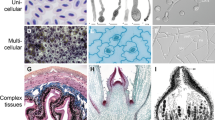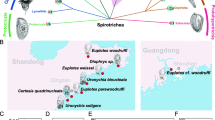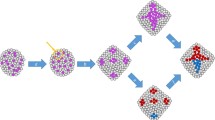Abstract
Evolutionary Cell Biology (ECB) has gained increasing attention in the last decades. Here we explore whether ECB is truly inter-disciplinary through the combination of cellular and evolutionary biology to offer evidence-based insights regarding the major questions of cell evolution. Since 2012, ECB asserts to utilize the increasing potential of high-throughput omics data (in silico) with morpho-functional (in situ) information, although challenges remain for a complete integration. For instance, the limited number of model organisms and cultivation techniques available excludes the majority of the extant diversity of cells from the scope of experimental inquiry. At the conceptual level, the simplification of evolutionary processes influenced by cultural views of evolution, such as adaptationism or Scala Naturae, challenges effective interdisciplinary work. Without a profound understanding of evolutionary theory and an integrative view of cell biology, the formulation of questions and experiments properly addressing evolution and diversification of cell complexities can become misleading. In 2009, we advanced the discovery of a nucleolus in the flagellated unicellular eukaryote Giardia lamblia, and studied nucleolus diversity in other lineages via electron microscopy. Since then, studying evolutionary questions at the cellular level became central to our research. We think that new methodological advances are re-shaping and strengthening the ECB research program and opening its door to experimental scientists. For example, the discovery of new archaea and protozoa and subsequent investigations that coupled in situ approaches with in silico approaches has proven that comprehensive morpho-functional information can be obtained that can only be understood through the merging of the cell biological and evolutionary discipline. Motivated by this, we here explore the history, the challenges, and the opportunities of ECB to motivate researchers to join this emergent field of research. We outline elements that contrast the current ECB discipline from previous integrative attempts. We conclude by elucidating the current disciplinary constraints of ECB and propose considerations towards successfully employing ECB to answer questions pertaining to the evolution of cellular complexity.

Similar content being viewed by others
References
Albarracín A 1983 La teoría celular: historia de un paradigma.
Alpers S 1983 With a Sincere Hand and a Faithful Eye: The Craft of Representation. In Svetlana Alpers: The Art of Describing. Dutch Art in the Seventeenth Century. University of Chicago Press: Chicago pp 67–69
Baldwin JE and Krebs H 1981 The evolution of metabolic cycles. Nature 291 381–382
Boulon S, Westman BJ, Hutten S, Boisvert F-M and Lamond AI 2010 The nucleolus under stress. Mol. Cell 40 216–227
Brodsky FM, Thattai M and Mayor S 2012 Evolutionary cell biology: Lessons from diversity. Nat. Cell Biol. 14 651
Caspers H 1964 Dobell, Clifford: Antony van Leeuwenhoek and his “Little Animals”. New York, N. Y.: Dover Publ. Inc. pp 503–503
Cobb M 2017 60 years ago, Francis Crick changed the logic of biology. PLoS Biol. 15 e2003243
Crick FH 1958 On protein synthesis. Symp. Soc. Exp. Biol. 12 138–163
Dayrat B 2003 The roots of phylogeny: how did Haeckel build his trees? Syst. Biol. 52 515–527
Dean AM and Thornton JW 2007 Mechanistic approaches to the study of evolution: the functional synthesis. Nat. Rev. Genet. 8 675–688
Dyall SD and Johnson PJ 2000 Origins of hydrogenosomes and mitochondria: evolution and organelle biogenesis. Curr. Opin. Microbiol. 3 404–411
Fildes P 1951 Leeuwenhoek lecture; the evolution of microbiology. Proc. R. Soc. Lond. B Biol. Sci. 138 65–74
Ford Doolittle W 1980 Revolutionary concepts in evolutionary cell biology. Trends Biochem. Sci. 5 146–149
Gonzalez Recio JC 1990 Elementos dinámicos de la teoría celular. Revista de filosofía (Madrid) 3 83–109
Grahame J and Avise JC 1995 Molecular markers, natural history and evolution. J. Anim. Eco. 64 538
Gribaldo S, Poole AM, Daubin V, Forterre P and Brochier-Armanet C 2010 The origin of eukaryotes and their relationship with the Archaea: are we at a phylogenomic impasse? Nature Reviews Microbiology 8 743–752.
Guy L and Ettema TJG 2011 The archaeal ‘TACK’superphylum and the origin of eukaryotes. Trends Microbiol. 19 580–587
Hooke R, Allestry J, Allestry J and Royal Society (Great Britain) 1667 Micrographia, or, Some physiological descriptions of minute bodies made by magnifying glasses : with observations and inquiries thereupon.
Jiménez-García LF, Zavala G, Chávez-Munguía B, Ramos-Godínez MP, López-Velázquez G, Segura-Valdez ML, Montañez C, Hehl AB, Argüello-García R and Ortega-Pierres G 2008 Identification of nucleoli in the early branching protist Giardia duodenalis. Int. J. Parasitol. 38 1297–1304
Keilin D 1959 The Leeuwenhoek Lecture - The problem of anabiosis or latent life: history and current concept. Proc. R. So. London. Se. B Biol. Sci. 150 149–191
King N 2004 The unicellular ancestry of animal development. Dev. Cell 7 313–325
Koonin EV and Yutin N 2014 The dispersed archaeal eukaryome and the complex archaeal ancestor of eukaryotes. Cold Spring Harb. Perspect. Biol. 6 a016188
Lane N 2015 The unseen world: reflections on Leeuwenhoek (1677) ‘Concerning little animals.’ Philosophical Transactions of the Royal Society B: Biological Sciences 370 20140344.
Lynch M, Field MC, Goodson HV, Malik HS, Pereira-Leal JB, Roos DS, Turkewitz AP and Sazer S 2014 Evolutionary cell biology: two origins, one objective. Proc. Natl. Acad. Sci. U. S. A. 111 16990–16994
Lynch M, Goodson HV and Turkewitz A 2012 Evolutionary Cell Biology: A report of the findings of the NSF-sponsored Workshop on Evolutionary Cell Biology held May 29-June 1.
Maehle A-H 2011 Ambiguous cells: the emergence of the stem cell concept in the nineteenth and twentieth centuries. Notes Rec. R. Soc. Lond. 65 359–378
Margulis L and Fester R 1991 Symbiosis as a Source of Evolutionary Innovation: Speciation and Morphogenesis. MIT Press.
Martin WF, Roettger M, Ku C, Garg SG, Nelson-Sathi S and Landan G 2017 Late Mitochondrial Origin Is an Artifact. Genome Biology and Evolution 9p.: 373–379.
Mayr E 2007 What Makes Biology Unique?: Considerations on the Autonomy of a Scientific Discipline. Cambridge University Press.
Mazzarello P 1999 A unifying concept: the history of cell theory. Nat. Cell Biol. 1 E13-5
Misteli T 2005 Concepts in nuclear architecture. Bioessays 27 477–487
Morange M 2009 What history tells us XVIII. When functional biologists propose mechanisms of evolution. J. Biosci. 34 373–376
Morange M 2011a How Evolutionary Biology Presently Pervades Cell and Molecular Biology.How Evolutionary Biology Presently Pervades Cell and Molecular Biology, in Darwinism, Philosophy, and Experimental Biology.
Morange M 2011b What will result from the interaction between functional and evolutionary biology? Stud. Hist. Philos. Biol. Biomed. Sci. 42 69–74
Nick P 2009 Evolutionary cell biology. Protoplasma 235 1
Nunoura T, Takaki Y, Kakuta J, Nishi S, Sugahara J, Kazama H, Chee G-J, Hattori M, Kanai A, Atomi H, Takai K and Takami H 2011 Insights into the evolution of Archaea and eukaryotic protein modifier systems revealed by the genome of a novel archaeal group. Nucleic Acids Res. 39 3204–3223
Nurse P 2003 a Systems biology: Understanding cells. Nature 424 883–883.
Nurse P 2003 b The great ideas of biology. Clin. Med. 3 560–568
Pittis AA and Gabaldón T 2016 Late acquisition of mitochondria by a host with chimaeric prokaryotic ancestry. Nature 531 101–104
Recio JLG 2016 La constitución de la citología y los modelos de la microanatomía celular. Ludus Vitalis 20 25–32
Richardson E, Zerr K, Tsaousis A, Dorrell RG and Dacks JB 2015 Evolutionary cell biology: functional insight from “endless forms most beautiful.” Mol. Biol. Cell 26 4532–4538
Roger AJ, Muñoz-Gómez SA and Kamikawa R 2017 The Origin and Diversification of Mitochondria. Curr. Biol. 27 R1177–R1192
Sagan L 1967 On the origin of mitosing cells. J. Theor. Biol. 14 255–274
Smith JM and Szathmary E 1997 The Major Transitions in Evolution.
Spang A, Saw JH, Jørgensen SL, Zaremba-Niedzwiedzka K, Martijn J, Lind AE, van Eijk R, Schleper C, Guy L and Ettema TJG 2015 Complex archaea that bridge the gap between prokaryotes and eukaryotes. Nature 521 173–179
Stanier RY and Van Niel CB 1962 The concept of a bacterium. Archiv für Mikrobiologie 42 17–35
Stent GS 1968 That was the molecular biology that was. Science 160 390–395
Williams TA, Foster PG, Cox CJ and Embley TM 2013 An archaeal origin of eukaryotes supports only two primary domains of life. Nature 504 231–236
Woese CR, Kandler O and Wheelis ML 1990 Towards a natural system of organisms: proposal for the domains Archaea, Bacteria, and Eucarya. Proc. Natl. Acad. Sci. U. S. A. 87 4576–4579
Zillig W 1991 Comparative biochemistry of Archaea and Bacteria. Curr. Opin. Genet. Dev. 1 544–551
Zuckerkandl E and Pauling L 1965 Molecules as documents of evolutionary history. J. Theor. Biol. 8 357–366
Acknowledgements
We want to thank our colleagues: Alejandro Fábregas Tejeda from Instituto de Biología at UNAM for his critical reading and comments on History of Science; Silvia Juárez Chavero and Teresa Jiménez Segura for her technical assistance; Prof. Edmundo Calva from Instituto de Biotecnología and Prof. David Romero from Centro de Ciencias Genómicas at UNAM for their critical reading. We also want to thank the two anonymous reviewers who greatly contributed to the final form of the manuscript with their critical reading and input. Parsifal Fidelio Islas- Morales is doctoral student from the “Programa de Doctorado en Ciencias Biomédicas, Universidad Nacional Autónoma de México (UNAM) and has received CONACyT fellowship 495217
Author information
Authors and Affiliations
Corresponding author
Additional information
Corresponding editor: Subhash C Lakhotia
Appendix
Appendix
1.1 Examples of ECB
1.1.1 Multicellularity and development
How organisms became multicellular is a question within the scope of inquiry of ECB that can contribute to the transdisciplinary research field of evolutionary developmental biology (informally, evo-devo). Evo-devo compares developmental processes across organisms to infer how developmental processes evolved. In the work of Nicole King on the origin of the multicellular condition, the cellular basis of development is split into characteristics and mapped onto the most recent eukaryotic phylogenies. Her work highlights that multicellularity has appeared many times in different lineages (e.g., across plants, fungi, and animals) and that many of the features of multicellularity were already present in unicellular ancestors. The different ways of how these ancestors evolved cell complexity sheds light upon the changes at the cellular level that prompted the evolution of developmental systems across the tree of life (King 2004).
1.1.2 Gradualism in eukaryogenesis – A focus for ECB
ECB has the potential of redefining fundamental questions in eukaryogenesis.
For example, gradualist scenarios are a more plausible way to explain the idiosyncratic cell complexity of eukaryotes, if we observe a rooted tree of life. Otherwise, the FECA-LECA transition is by itself a non-gradualist conception based on the assumption that ancient proto-eukaryotic lineages disappeared. In fact, if cell complexity was acquired gradually, we have limited understanding with regard to how simple or even how eukaryotic a hypothetical FECA should have been. In a gradualist scenario, the nature of the sister group of eukaryotes is critical to explore in order to define the attributes exclusively associated with eukaryotes and which attributes were already present in common ancestors. Based on this, we can ask: how are in silico evidenced homologs entities organized and functionally involved in the cells of the sister group of eukaryotes? Can we find them in any kind of ancestral compartment, or do they provide different functions related to a completely different cellular context?
In a two-domain tree of life, TACK-Archaea are the monophyletic sister group of eukaryotes. TACK-Archaea then represent a source of evolutionary characters and ancestral states through comparative approaches. As pointed out by Simonetta Gribaldo: in a two-domain tree of life late or early mitochondrial endosymbiosis does not affect a gradualist cellular diversification. FECA is no longer the un-rooted starting point of eukaryogenesis. And eukaryogenesis converts into a result of cell evolution within the TACK Archaea (Williams et al. 2013; Gribaldo et al. 2010).
The question for ECB would be: which eukaryotic cell features do TACK-Archaea have? Based on the extant and still unveiled diversity of TACK Archaea, how can we approach a real gradualist reconstruction for each common ancestor?
We should be aware of the possibility that many TACK-archaeal lineages, which represent intermediate states, might be already extinct or are highly modified. What is the proof of concept to establish homology between archaeal and eukaryotic compartments or structures? TACK archaeal genes and protein domains are heterogeneously conserved and derived among different eukaryotic families. The notion of a Dispersive Archaeal Eukaryome (Koonin and Yutin 2014) suggests that a comparative approach to prokaryotic and protist cell architecture is needed in order to relate molecular homologs to their cellular context, their putative function, and their evolutionary meaning. For instance, homology between structures can be established if the products of molecular homologs are localized in the same cellular feature(s) in two related lineages. Even if the compartment or structure is highly derived, cell compartments of distant lineages can be homologous if molecular characters support a monophyletic relation and can be structurally related to a similar cellular context. Then the structure can be attributed to a common ancestor or be seen as a derived character.
1.1.3 Omics-driven ECB
In 2016 Pittis and Gabaldón proposed that the acquisition of mitochondria was a late event in eukaryogenesis. Using an omics approach these authors identified monophyletic groups of genes to be present in LECA with their prokaryotic orthologs. So-called Eukaryotic Protein Families (EPF) are monophyletic and relate to specific cell compartments being able to explore its history between prokaryotes and LECA, namely in the FECA-LECA transition. For instance, alpha-proteobacterial proteins represent mitochondria, while fibrillarin orthologs in Archaea represent nucleoli. By reconstructing phylogenies of each EPF, and evaluating branch lengths separating eukaryotic and prokaryotic sequences with a molecular clock methodology, they conclude that EPFs of archaeal origin tended to be closer to FECA, whereas genes of mitochondrial were closer to extant eukaryotes. The authors suggested that with this measure, as mitochondria have the shortest phylogenetic distance, they would have been the last organelles to be incorporated in an evolving FECA-LECA transition. In contrast, membrane trafficking compartments and ribonucleoproteins had been acquired long before the mitochondrial acquisition (Pittis and Gabaldón 2016). These studies have been criticized by Martin and collaborators, pointing out that the difference in stem lengths of EPFs are not statistically significant, due to the use of a strict molecular clock, meaning evolutionary rates can be considered the same across the complete phylogeny (Martin et al. 2017). According to Roger and collaborators: ‘this objection fails to acknowledge the possibility that even if no single gene evolved in a clock-like manner, increases and decreases in rates across lineages and proteins could cancel so that the average of stem lengths of a large protein set may be roughly clocklike’ (Roger et al. 2017).
Despite this methodological discussion, Pittis and Gabaldón conclusions are interesting in the light of ECB. Based on a two-domain tree of life, if EPF homologs existing in TACK-archaeal phyla are mainly orthologs, the search for the ancestral states of eukaryotic compartments in the order suggested by these authors should rely on experimental studies of extant TACK-Archaea. An approximation to the nature of early cell compartments could be addressed with the following question: How are these orthologs distributed and organized cells of Archaea?
1.1.4 Nuclear architecture
Nuclear architecture involves the form and function of nuclear bodies (Misteli 2005). These concepts are inherently related to the question of the origin of the cell nucleus. A special example is the nucleolus. The nucleolus is a multiproteic complex of close to 300 different proteins that are involved with processes as important as programmed cell death, metabolic regulation, cell differentiation, stress, and aging (Boulon et al. 2010). All these processes converge to the core process occurring in the nucleolus, namely the transcription and maturation of ribosomal RNA. The nucleolus can be considered a domain of ribosomal gene expression.
The discovery that Giardia lamblia (a flagellated protozoan and intestinal parasite with pediatric relevance) harbors a nucleolus (Jiménez-García et al. 2008) was for us the motivation to address the evolution of nuclear architecture from an ECB perspective. Phylogenies placed Giardia as part of ‘primitive’ or ‘early branching lineage’, known as diplomonads. These notions were misleading because eukaryotic phylogenies lack a root. We don´t know if Giardia were among the first eukaryotes to branch, and certainly, since Giardia are parasites with a long history of secondary losses and modifications of their organelles, there is no compelling argument to assume that they are primitive in comparison to other protozoa. However, this ambiguity of the evolutionary meaning of Giardia revealed the real value of our contribution. Before our confirmation, G. lamblia was considered the only anucleolated eukaryote. The discovery of Giardia nucleoli implicated a major advance, namely that, regardless of un-rooted phylogenies, nucleoli represent a character shared among all eukaryotes (a synapomorphy). The Last Eukaryotic Common Ancestor (LECA) should also harbor a nucleolus.
Rights and permissions
About this article
Cite this article
Islas-Morales, P.F., Jiménez-García, L.F., Mosqueira-Santillán, M. et al. Evolutionary Cell Biology (ECB): Lessons, challenges, and opportunities for the integrative study of cell evolution. J Biosci 46, 9 (2021). https://doi.org/10.1007/s12038-020-00129-z
Received:
Accepted:
Published:
DOI: https://doi.org/10.1007/s12038-020-00129-z




